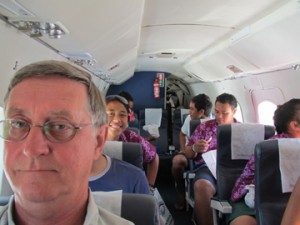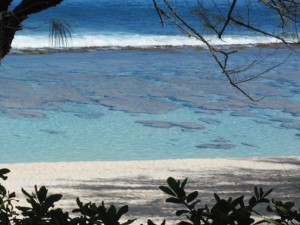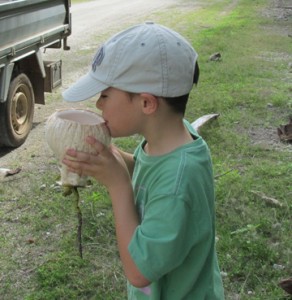Atiu

I am sitting on the back porch of Paradise. My private villa/bungalow on the island of Atiu enjoying coffee and the sunrise. The flight from L.A. to Rarotonga in the Cook Islands was smooth and comfortable, business class is certainly nice on the long haul flights. We got in around 6 AM and I lolled around the airport until my flight at 11 to Atiu. The plane held 16 if you count the pilot and copilot. I loved the safety speech, the pilot turned around and said: “ Fasten your seat belts please, there is an exit at the back and two in the front.” then we took off. The agency I booked the air tickets and hotels through said they would leave my vouchers at the Air Raro desk in Rarotonga, and they did. But the staff there sent them on to Atiu on an earlier flight for unknown reason, but no problem just ask for them when I get to Atiu. At Atiu they told me how they sent them back to Rarotonga on the earlier flight but not to worry, they would send them back here on the next flight. That would be in two days when the plane takes me to Aitutaki. Nobody seems to worried, so either am I, it will no doubt work itself out. (remember rule number one).
This was a perfect place to meet the South Pacific. Atiu is about 5 kilometers across. (I am going to try going metric since the entire world except America does, 1 mile =1.2 Km) (correction, 1 mile = 1.6 Km., thanks Jimmie.) Population 482 not counting the 11 tourists on the island right now. My host Roger Malcolm picked me and an Italian couple up at the airstrip and gave us a nice introduction to the island on our way to the villas. He came here 30 years ago with a portable saw mill and cut and milled the wood and built the 6 villas and bar/restaurant himself. Amazing woods and workmanship. The Island is a “Makatea” island. That means “raised coral”. It began as an underwater volcano which slowly was raised as the tectonic plates sub-ducted. It was slow enough that the waves wore away the top of the volcanic crater and smoothed off the top. Finally the island was high enough the waves couldn’t wash over it any more and it rose as a flat land mass. A ring of coral formed around the island maybe a kilometer wide. As the time passed, the island rose more and lifted this coral out of the sea, making it 100,000 year old coral reef 30 to 40 meters above sea level. This area is called the Makatea. At the sea now is another ring of coral making a shallow (1-2 meter) lagoon that goes out 50 to 100 meters where the waves break over it and then 50 meters further out it drops off fast to deep water.
If you imagine what coral reef looks like underwater, you can picture what it is like to walk over it above water, not so easy all the time. Yesterday was a long day, two tours and the Tumunu. In the morning I went with “Birdman George” who showed me around the island, looking at the various birds, including the Kakerori (Rarotonga Flycatcher), possibly the rarest bird in the world. Down to 28 birds they started a recovery program some years ago, and now have more than 250. Very protective and territorial they are easy prey for the ship rats that have gotten on the islands. George climbed a coconut tree and got us fresh coconuts which were different than any I have had before. After husking them, they were no the hard, dark brown shelled nuts, 1/2 full of water. They were almost white, and soft enough that using his machete with light chops was able to cut the top off, not crack it off. About a liter of water, less sweet than I have tasted and so more refreshing. The coconut meat was so soft that I could scrape it out of the shell with the side of my finger, not struggling with a knife like the dry coconut of the stores. Very mild and tasty. Now I can see how this is survival food.
In the Afternoon four others and I went on a tour with Marshall Humphrey to the Anatakitaki cave. We hiked 2.5 Km roundtrip over the Makatea to the cave entrance. As he told us, “when the guide picks up a walking stick it is a good sign that you should too.” True advice. Walking over the coral and on the sort of trails was as they advertise, a “challenging 30 minute nature walk” which explains the waiver I signed. Off the trail would have been crazy hard to move along. At the cave entrance we went down a 4 meter ladder and put on the headlamps. These were very amazing caves; stalactites, stalagmites, columns, curtains, “popcorn” and flowstones. The roots of the Banyon trees above reach down and find a way through the stone and emerge from the cave roof, grown down until they hit the floor and root in making a wooden curtain. A fair amount of slippery spots, hold here, help each other over this and sliding on your butt. The caves are beautiful enough on their own to be worth the walk but there is another thing to see. The Kopeka bird! This is a 15 cm. Bird unique to Atiu that lives in the caves, goes outside to hunt insects and returns to the cave. While outside they don’t ever land, just hunt and eat. They have a melodious “outside” call and very good eyesight. When they go back into the cave they click like a bat and echolocate! They go deep into the cave, to where it is black and nest on the walls and nooks in the roof. When he would shine a light they would visually navigate and then turning it off they would click like a geiger counter. We went about 100 meters into the cave and Marshall showed us nests, flying birds, and the crabs that live in the cave and are the main predator and threat to the birds.
After the hike back out we stopped by the Tumunu for a drink. The Atiuans are the only ones that fought the church and state long and hard enough to legalize the brewing of “bush beer”. Some of the old spirit no doubt. The locals meet at the Tumunu to share stories, talk, and drink bush beer. It is made from Guava and is about 14% alcohol. The Italians and I went, met Papa and another at “Sam and the Boys” place. A small half coconut shell (1/4 cup) is dipped into the bucket and passed over, drink that and pass it back. The leader then dips again and passes to the next and so on around the circle. After a few shots the conversation flows and more shots. Around 10 times or so Marshall came back to pick us up for the ride back to the Atiu Villas for dinner. I slept hard last night. Today I say farewell (Aere ra) to Atiu and Hello (Kia Orana) to Aitutaki.
Tags: Travel




July 28th, 2011 at 1:04 pm
so glad to see traveling is still suiting you well.
Take care and thanks for teaching mb the rules!
Rick, Marybeth and Preston
July 28th, 2011 at 3:52 pm
Jim.
Your first attempt at going metric came up a little short. urf. urf. (A bit of mesuration humour here.) But perhaps these are Cook Island miles, and perhaps the king of Rarotonga had a smaller foot than the king of England.
It all reminds me of the Gimli glider incident from 1983. Canada had recently gone metric, and the Boeing 767 was a new aircraft. The fuelling crew used a wrong conversion factor, so the plane took off with only half the required amount of fuel. The fuel gauge did not measure the fuel directly. Instead it reported a calculation of what SHOULD be there. Half way between Montreal and Edmonton, over Red Lake, Ontario (wilderness, man) things began glowing and beeping and shutting down. With no engines, there was almost no electricity or hydraulics. The pilot managed to glide it a long, long way to a decommissioned air base at Gimli. The ex-air base was now a race track. The racers couldn’t hear the silent plane approaching.
If your hair feels in need of a raising, you can google the tale under ‘Gimli glider’.
July 30th, 2011 at 7:17 pm
The altitude must have given my brain gas, an enormous brain fart. yes even here it is 1 mile = 1.6 Kilometers. I think I will wait until after flying around the south pacific in these tiny planes before I read about near misses with aircraft.